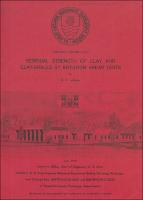Please use this identifier to cite or link to this item:
https://hdl.handle.net/11681/20518| Title: | Residual strength of clay and clay-shales by rotation shear tests |
| Authors: | Harvard University LaGatta, Daniel P. |
| Keywords: | Clay-shales Clays Residual strength Shear strength Shear tests Soil mechanics Shale |
| Publisher: | U.S. Army Engineer Waterways Experiment Station. Engineer Research and Development Center (U.S.) |
| Description: | Contract Report Purpose: The objectives of this investigation were to (A.) develop a rotation shearing machine to measure the residual shear strength (constant shearing resistance at which material undergoes continuous deformation under a constant state of effective stress) of clays and clay-shales; (B.) investigate testing errors; and (C.) measure residual shear strengths of representative types of highly plastic clays and clay-shales. In the rotation shear test, torque is applied to the bottom of the specimen and two force transducers measure the couple necessary to maintain the upper half of the specimen stationary. Disc-shaped or annular specimens with thicknesses from 0.1 to 2.5 cm and outside diameters of 7.11 cm can be tested, The inside diameter of annular specimens is 5.08 cm. Vertical stresses up to 200 kg per cm² on annular specimens are applied by a lever system. Rates of rotation can be varied from one revolution in 40 minutes to one revolution in 28 days. It was found that soil extrusion from the peripheral boundaries of the specimen introduce error by causing redistribution of the vertical stress on the specimen, with the error increasing as the ratio of inner radius to outer radius of the annular specimen decreases and as the rate of soil extrusion increases. Other errors evaluated were those resulting from inaccuracies in the lever system, side friction of confining rings, and errors in moment due to the electronic measuring system and due to friction between the center disc and the inner periphery of annular specimens. Remolded specimens of three materials (Pepper shale, Cucuracha shale, and London clay) tested under an effective normal stress of 8 kg per cm² had residual friction angles varying from 7.3 to 8.4 deg. Variations in residual shear strength were investigated for normally consolidated versus overconsolidated specimens, for specimens sheared at different rates of peripheral displacement, and for specimens prepared by several different remolding procedures. NOTE: This file is large. Allow your browser several minutes to download the file. |
| Rights: | Approved for public release; distribution is unlimited. |
| URI: | http://hdl.handle.net/11681/20518 |
| Appears in Collections: | Contract Report |
Files in This Item:
| File | Description | Size | Format | |
|---|---|---|---|---|
| CR-S-70-5.pdf | 54.26 MB | Adobe PDF |  View/Open |